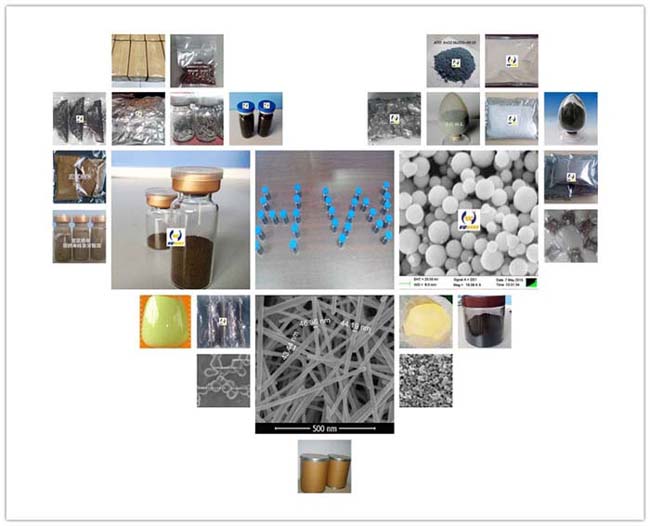The nanometer (nm) is the smallest unit of measure after the micron, and the nanometer is one millionth of one millimeter, that is to say, nanometer is one billionth of a meter. Nano silver powder is made through cutting-edge nano-technology. The emergence of silver powder in the nanometer state, promotes a qualitative leap of bactericidal ability, very few nano-silver can produce a strong bactericidal effect. It can kill more than 650 kinds of bacteria in a few minutes, with broad-spectrum sterilization and no resistance, whihc can promote wound healing, cell growth and repair damaged cells, without any toxic reactions, find no any stimulus response to the skin. All this opens up a broad prospect application of antimicrobial of nano silver powders,and become the latest generation of natural antibacterial agents. Nano silver sterilization has the following characteristics:
1. Broad spectrum antimicrobial
Nano-silver particles directly into the cell, work with oxygen metabolism enzyme (-SH), make the bacteria asphyxia and death of the unique mechanism of action, which can kill contact with most of the bacteria, fungi, mold, spores and other microorganisms. It has found that it has comprehensive antibacterial activity against drug resistant pathogens such as Escherichia coli, Staphylococcus aureus, Pseudomonas aeruginosa, Streptococcus pyogenes, Enterococcus, and anaerobic bacteria. Fungi such as Staphylococcus aureus, Escherichia coli, Pseudomonas aeruginosa, Candida albicans and other G +, G-pathogens have bactericidal effects on Chlamydia trachomatis, causing sexually transmitted diseases. Neisseria gonorrhoeae also has a strong bactericidal effect.
An antibiotic can kill about 6 pathogens, while nanoscale silver can kill hundreds of pathogenic microorganisms. Strong effect to kill bacteria, fungi, trichomoniasis, chlamydia / chlamydia, Neisseria gonorrhoeae, bactericidal, the same effect for antibiotic resistance!
2. Potent sterilization
According to the study, it’s found that Ag can kill more than 650 kinds of bacteria in a few minutes. Nano-silver particles and pathogens after the cell wall / membrane binding, can directly into the cell, quickly with the oxygen metabolism of the enzyme thiol (-SH) binding, the enzyme inactivation, blocking the respiratory metabolism to suffocate. Unique bactericidal mechanism, so that nano-silver particles in the low concentration can quickly kill pathogens.
3. Permeability is strong
Nano-silver particles with superior permeability, can quickly penetrate the skin 2mm sterilization, have a good bactericidal effect on the common bacteria, stubborn bacteria, drug-resistant bacteria and fungi caused by deep tissue infection.
4. Repair regeneration
Nano silver can promote wound healing, promote the repair and regeneration of damaged cells, to rot myogenic, anti-bacterial anti-inflammatory to improve the microcirculation around the wound tissue, effectively activate and promote tissue cell growth, accelerate wound healing, reduce scar generation.
5. Antibacterial lasting
Nano-silver particles using patented technology, a layer of protective film, in the human body can be gradually released, so antibacterial effect
6. Safe and non-toxic
As early as the “Compendium of Materia Medica” records: raw silver, non-toxic; US Public Health Bureau in 1990, “on the toxicity of silver investigation report” that: silver on the human body no obvious side effects; nano silver is topical, Is the safest way to use it. According to the experimental study found that mice in the oral maximum tolerance of 925mg / kg, which is equivalent to the clinical use of 4625 times the dose, without any toxic reactions in the rabbit skin irritation experiments, did not find any stimulus response.
7. No drug resistance
Nano-silver is non-antibiotic fungicide: nano-silver can kill a variety of pathogenic microorganisms, stronger than antibiotics, 10nm size of nano-silver particles unique antibacterial mechanism can quickly kill bacteria directly to the loss of reproductive capacity, therefore, can not produce Drug resistance of the next generation, can effectively avoid the resistance caused by recurrent long-term treatment.
Hongwu Nano, an expert in manufacturering in nanopowders since 2002, especialy nano Silver powders with the best antibacterial property.
High purity,99.99%, good shape,spherical, uniform particle size, easy to disperse nano silver powders are supplied.
Generally speaking, the smaller particle size of Ag nanoparticles, the better bactericidal effect.
Silver nanopowders can not only be available for powders state, but also nano silver antibacterial solution, which is ready to be used, is available.
The concentration of nano silver antibacterial solution is 1000PPM commonly. Other concentration of the solution can be customized.
Related Tags:silver nanoparticles antimicrobial silver nanoparticles applications in medicine

